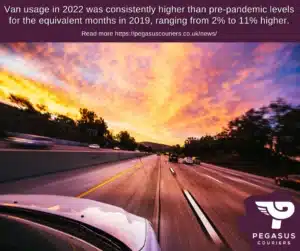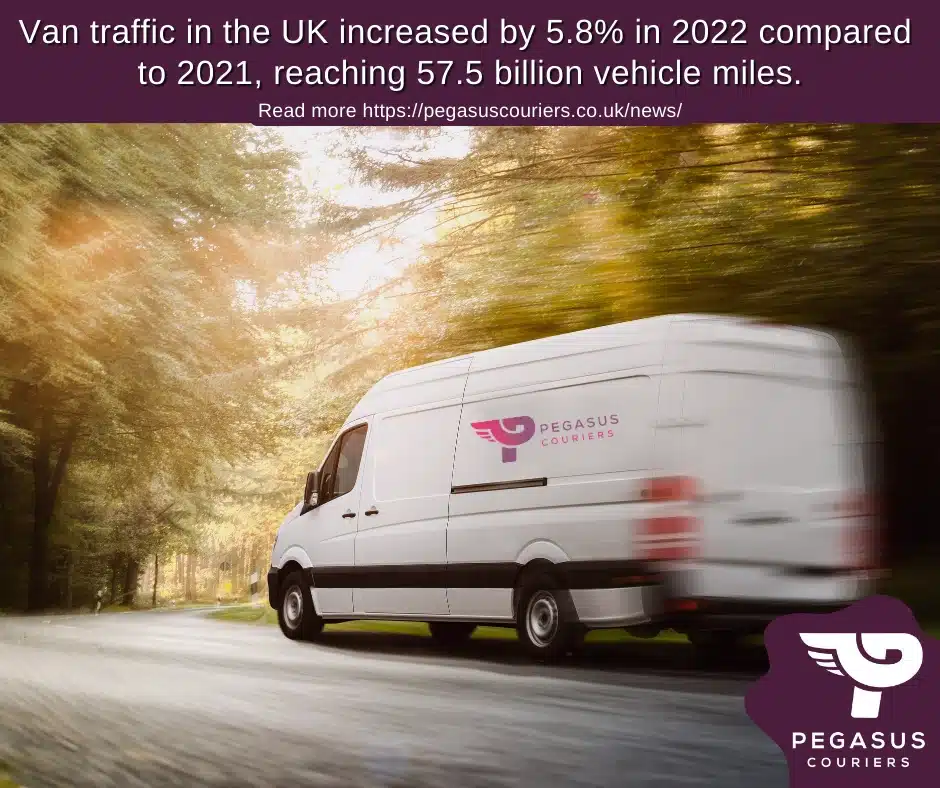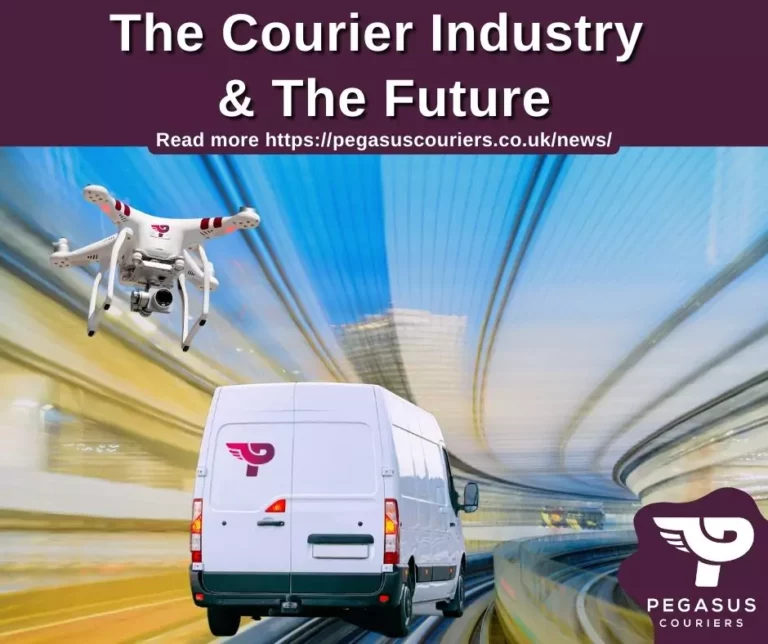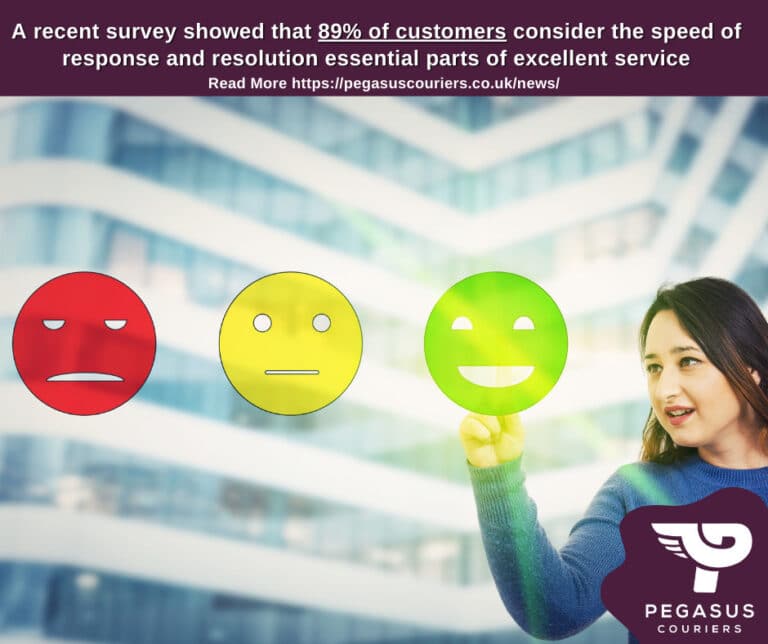Van Mileage Increase Shows Booming E-commerce and Delivery Services?
Phil West

UK van traffic reached a 10-year high, signalling an improving economy and growth in several sectors, such as online shopping.
In this article, Phil West, Director of Pegasus Couriers, provides insight into the latest van mileage figures and what this trend means for growth.
Courier Van Traffic Surge Reflects Market Increase
The growth in courier van numbers on our streets directly responds to the booming demand for delivery services, fuelled by changes in consumer behaviour and a robust e-commerce industry.
The latest government figures reveal an astonishing increase in van traffic mileage nationwide.
The 2022 figures, released this month, show that van traffic across Great Britain reached an astounding 57.5 billion vehicle miles, marking a 5.8% rise compared to 2021 and a remarkable 7.6% increase from 2019.
In fact, van miles travelled in Great Britain reached a 10-year high peak in 2022.
This rise in van traffic underscores the importance of developing effective logistic strategies to manage the increasing delivery load. As the courier sector tackles these issues, it’s turning to innovative solutions like electric vans and drones to boost sustainability and efficiency.
Why is this happening? The shift towards online shopping has permanently altered what consumers expect from delivery services. Most people now anticipate fast, reliable, and eco-friendly delivery options. In response, courier services are evolving rapidly to meet these expectations.
The courier industry’s proactive approach to adopting these technologies addresses environmental concerns and enhances operational efficiency. As we continue to witness this evolution, it’s clear that couriers are crucial in bridging the gap between online retailers and customers.
Gridlock and Courier Market Impact
Increased Demand for Courier Vans: A Reflection of Growing E-commerce Trends
The recent uptick in van traffic is a clear indicator of the burgeoning demand for courier services, primarily driven by the continued expansion of e-commerce. As more people shop online, the need for reliable delivery services becomes more crucial. Courier vans are at the heart of this system, ensuring customers receive their purchases promptly and businesses can thrive by meeting these increasing demands.
The Impact of E-commerce on Courier Services
With online sales hitting record highs, the logistics sector must adapt rapidly. The surge in e-commerce necessitates a more significant number of courier vans on our roads. This increase is not just about quantity; it’s about enhancing the quality of service. Timely deliveries are no longer a luxury but a standard expectation from consumers. According to a recent study, late deliveries can lead to a 30% increase in customer dissatisfaction rates, highlighting the critical role of efficient courier services.
The Crucial Role of Efficient Courier Services
Efficient courier services are the backbone of both business success and customer satisfaction. As delivery needs escalate, the pressure on courier services to perform efficiently grows. Implementing advanced route planning software and real-time tracking systems are just a few ways these services are evolving to meet demands effectively.
Meeting the Future of Deliveries Head-On
As we look to the future, the role of courier vans is undeniably pivotal. Companies that invest in upgrading their fleet, adopting sustainable practices, and improving delivery efficiencies will stand out in this competitive market.

Soaring Traffic And Courier Driver Growth
As e-commerce continues to expand, more people are shopping online, leading to an increase in courier jobs and busier city streets. This trend is particularly noticeable in urban areas where more people live and shop. The surge in courier jobs reflects the growing demand for delivery services and highlights the vital role of efficient road networks. These networks are crucial in helping courier drivers deliver packages quickly, ensuring customer satisfaction.
Courier drivers are central to the success of delivery services, as their timely deliveries directly impact customer happiness. With the ongoing rise in van traffic, these drivers are finding more job opportunities, enhancing their job security. This is crucial in urban settings where the demand for quick delivery services is higher due to the dense population.
Moreover, the increased traffic has underscored the need for more thoughtful city planning and better traffic management to keep cities moving smoothly. Some cities are looking into solutions like dedicated delivery zones and improved routing technology to address these challenges.
To support these claims, recent studies have shown that e-commerce grew by over 20% last year, leading to a parallel increase in courier jobs. This growth in the courier sector is not just a temporary trend but a significant shift in how we shop and receive goods.
In summary, the rise in courier jobs and van traffic clearly indicates the evolving commerce landscape, driven by our increasing reliance on online shopping. Efficient road networks and effective city planning will meet these new challenges and ensure that deliveries remain speedy and reliable. As one industry expert said, ‘In the fast-paced world of e-commerce, efficient delivery services are the backbone of customer satisfaction.
This trend towards more courier jobs and busier roads doesn’t just represent a challenge; it’s also an opportunity for cities to innovate and for job seekers to find stable employment in a growing field.
Pandemic Record Highs
Since 2012, van traffic in Great Britain has steadily increased, reaching a record high of 57.5 billion vehicle miles in 2022. This spike in van traffic significantly contributes to road congestion and environmental issues due to increased emissions. More vans on the road also mean more wear and tear, leading to problems such as potholes and increased traffic accidents.
The need to mitigate these challenges is pressing. A promising solution is the adoption of electric and autonomous vehicles. These technologies offer a cleaner alternative, helping to reduce emissions and potentially decrease the number of accidents caused by human error.
Quick Facts on Courier Market
- Van traffic in the UK increased by 5.8% in 2022 compared to 2021, reaching 57.5 billion vehicle miles.
- Van traffic in 2022 was 7.6% higher than in 2019, indicating a significant growth in van usage over the years.
- Van traffic on motorways accounted for 22% of the total van miles, while ‘A’ roads accounted for 42%, and minor roads accounted for 36% in 2022.
- Monthly trend in van traffic showed that van usage in 2022 was consistently higher than pre-pandemic levels for the equivalent months in 2019, ranging from 2% to 11% higher.
Where Are You More Likely To Spot A Courier Van?
- Motorways – While commonly used, many route calculation navigation devices (SatNav) prompt delivery drivers to use the quickest route. 12.8 billion vehicle miles were recorded on the UK’s motorways, representing 22% of the total. This could be due to motorways providing faster and more efficient van routes, particularly long-distance deliveries.
- ‘A’ roads – These types of roads see a higher volume of van traffic, with 24.1 billion vehicle miles recorded, accounting for 42% of the total. This suggests that vans are commonly used for local and regional deliveries, where ‘A’ roads are often the main transportation routes.
- Minor roads – 20.6 billion vehicle miles travelled by vans, making up 36% of the total. This indicates that vans are also frequently used for smaller, local journeys, for more local courier deliveries from online shopping.
Couriers Help the Local Economy
Increased traffic and the growth in courier jobs due to the rise of online shopping have significantly changed urban environments and boosted local economies. Couriers are crucial because they enable efficient logistics and ensure prompt deliveries, which support local businesses and services. Well-maintained and capable road networks are vital, particularly on major regional roads, to handle the growing needs of courier deliveries. Vans, often used by couriers, are indispensable in delivering these services, aiding community support and fostering economic development.
The courier industry’s dependence on robust road networks is a testament to how intertwined it is with the health of local economies. For example, a recent study showed that improving road infrastructure by just 5% in urban areas could enhance courier delivery efficiency by up to 20%, significantly boosting local businesses that rely on timely deliveries.
Moreover, specific examples like using electric vans in courier fleets can illustrate the industry’s adaptation to modern challenges. These vehicles reduce the carbon footprint and decrease the operational costs for courier services, passing savings onto consumers and contributing further to local economic vitality.
Efficient logistics are more than just a way to move items from point A to point B; they are a lifeline for small businesses and boost local economies, proving that every well-timed delivery helps weave the fabric of a thriving community.
An industry expert notes that ‘every package delivered on time represents not just a transaction but a building block in the foundation of a robust local economy. ‘
This focus on improving courier services and infrastructure meets current demands and anticipates future needs, ensuring that local economies remain vibrant and resilient. Integrating technology and sustainable practices within the courier sector also highlights a commitment to future-proofing this essential service.
The Future of The UK Courier Industry
Courier drivers are the unsung heroes of our daily lives, quietly traversing our roadways and ensuring that goods and services reach their intended destinations efficiently. They are the backbone of our economy, facilitating the smooth operation of various industries, including deliveries, healthcare, and agriculture. Future projections for courier van traffic growth suggest that the upward trend will continue. The rise in courier services post-pandemic reflects the increasing demand for delivery solutions driven by the popularity of online shopping. However, this growth brings challenges such as heightened road congestion and emissions, raising environmental concerns.
Understanding the real-world impact of each online order is crucial. With more vans on the road, there is a need for sustainable transportation solutions that can meet consumer needs while minimising environmental harm.
Balancing convenience with sustainability is key. Transitioning to electric vehicles and optimising delivery routes are practical steps towards reducing pollution. Encouraging consumers to opt for eco-friendly delivery choices or consolidate shipments can also make a positive impact.
Moving ahead, we must find a harmonious balance between the convenience of online shopping and environmental preservation. Embracing clean energy solutions and efficient logistics will ensure that the ease of online shopping doesn’t compromise our planet’s well-being.
Common Questions and Answers: Courier Van

Cyber Crime in the Courier Industry
Like most industries, criminals constantly adapt, making it important to be mindful of the latest trends.

Future of the Courier Industry
The courier industry is vital to the global economy, transporting goods to consumers worldwide.

Customer Service & Couriers
The importance of customer service to end consumers is vital for success.

Manager Promoted to Director
Leading logistics company Pegasus Couriers has promoted Dedicated Service Provider (DSP)
Operations Manager.